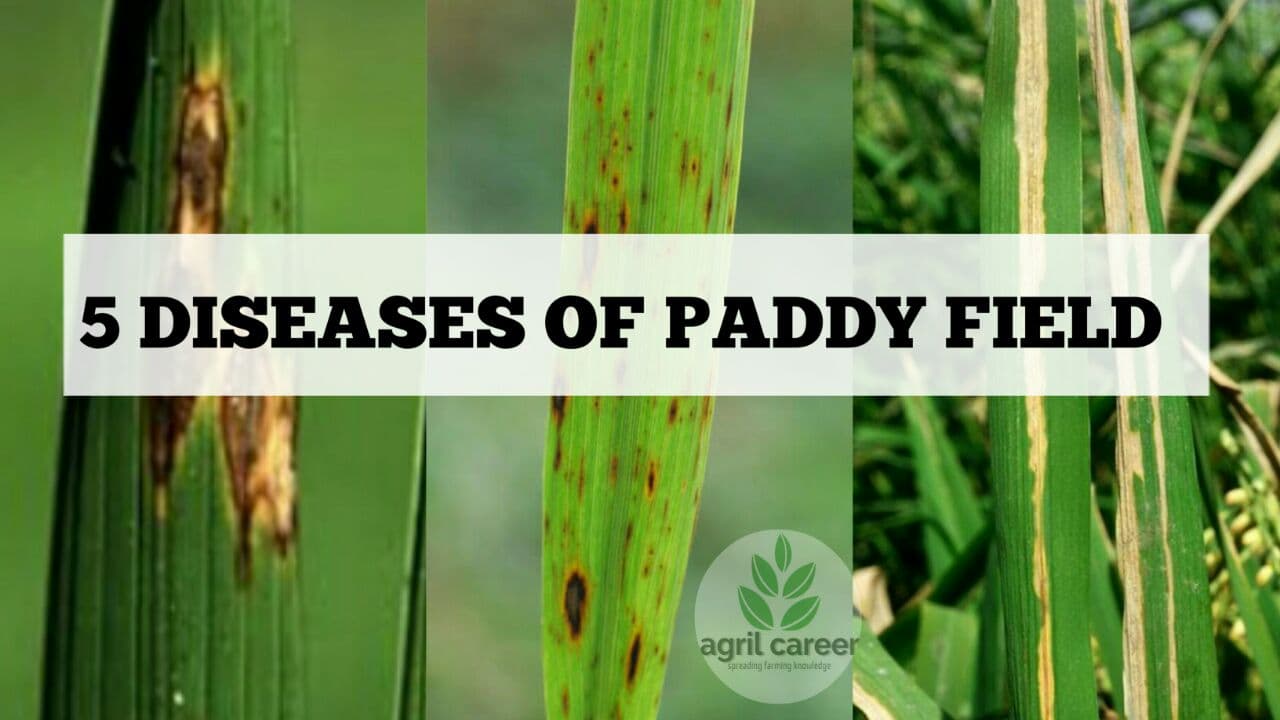5 Diseases in Paddy field
5 DISEASES IN PADDY FIELD
A. BROWN SPOT –
Causal organism – Helminthosporium oryzae.
Brown leaf spot occurs in all rice- growing areas . The disease attacks the crop from the seedling stage in the nursery to the milk stage in the field. Spots vary in shape and size and appear on the coleoptiles of the leaves, leaf sheath, and glumes
Symptoms –
1. Initially the spots appear as small circular to oval shape on the first seedling leaves.
2. The spots may vary in sizes and shape, and observed throughout the whole seasons.
3. The shape , size and colour of spots depend on the environment condition, age of the spot etc.
4. Small spots are dark brown to reddish brown while large spots have a light, reddish-brown or gray.
Management –
1. Use of resistant varieties – Rasi, IR 36, Jagannath.
2. Do not use high nitrogenous fertilizer.
3. spray 1g of ediphenphos or 2g mancozeb
4. Avoid water stress.
5. Use disease free seed for sowing from reliable source.
B. BACTERIAL BLIGHT –
Causal organism – Xanthomonas oryzae.
Bacterial blight is one of the most destructive disease of rice cultivation. In severe epidemics, crop loss may be as high as 75 percent due to this bacteria.
Symptoms –
1. First the infected leaves of seedlings become yellow an later wilt and die.
2. Bacteria attack on mature plant from penicle formation to tillering stage.
3. Light green to greyish green colour lines appear on leaves.
4. In the final stage of infection milky bacteria ooze can be observed dripping from the leaves.
5. These pathogen spread from wind and rain splash.
Management –
1. Apply product based on copper.
2. Ensure proper drainage system in the field.
3. Avoid use of nitrogen in form of urea.
4. Allow the soil to dry between two seasons.
5. Use certified seeds.
C. BLAST IN PADDY –
Causal organism – Magnaporthe grisea.
Rice blast, caused by a fungus, causes lesions to form on different part of plant. This disease ranks among the most important plant diseases of paddy.
Symptoms –
1. lesions can be found on all parts of the plant.
2. Sometimes even roots can become infected.
3. lesions may initially appear gray-green and water-soaked.
4. Collar infections can kill the entire leaf.
5. lesions often remain small in size (1-2 mm).
Management –
1. Crop rotation is one simple and effective technique.
2. Do not overuse of nitrogen fertilizers.
3. Maintain the water level of paddy Field.
4. use high quality and disease-free seed.
5. Use of chemical fungicides to control the disease.
D. FLASE SMUT OF PADDY –
Causal organism – Ustilaginoidea virens.
Rice false smut is the most important grain disease in rice production. Its epidemics not only lead to yield loss but also reduce grain quality. The pathogen attacks spikelets and converts into an RFS ball made up of powdered chlamydospores covered with mycelia.
Symptoms –
1. Yellowish to orange small balls develop on the grains which later turn black.
2. Growth of velvety spores enclose floral parts.
3. When the spore grows, it causes damage and breaks the membrane.
4. There are only few grains infested in the penicle and rest remain normal.
Management-
1. Deep ploughing to at least 6 inch.
2. Spray a fungicide 6-8 days before flowering.
3. Spray – Hexaconazole 5% SC at 1ml/litres or Chlorothalonil 72% SC at 2gm/ liters
4. Remove weeds, grasses from the field.
5. Treat seed at 52℃ for 10 min.
E. RICE GRASSY STUNT –
This Disease is a virus disease spreads by the brown plant hopper, Nilaparvata lugens
Rice grassy stunt virus affects rice crops in areas where continuous all-year around rice growing is practiced. The virus is transmitted between plants by insect vectors.
Symptoms –
1. Grassy and rosette appearance of plants.
2. Numerous small rusty spots or patches on leaves.
3. Leaves turn yellow even after applying enough nitrogen.
IFFCO Nano Urea/Nitrogen (Click here to read)
Thanks for reading. Jai Hind Jai Kisan !


